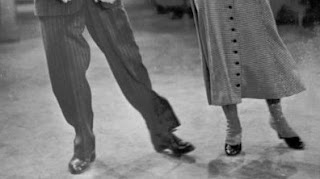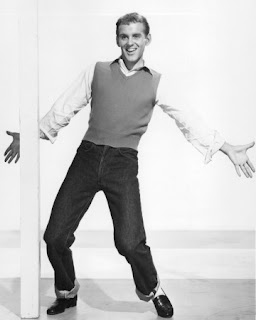Jeanine Basinger's I Do and I Don't is clearly the work of extensive, passionate research. The film historian explains that marriage is rarely the main subject of films and certainly never advertised as such. In order to give the marriage movie a face, she viewed hundreds of films in search of plots where "the state of being married" was the sole focus (xvi). Basinger divided her findings into three sections: The Silent Era (20 pages), The Studio System (280+ pages), and The Modern Era (50+ pages). Each is peppered with photographs (on the back inside flap, the book boasts 139 illustrations), which give visual support to Basinger's assertions.
It is supreme irony that moviegoers could be conned into believing in romance that led to happy endings in one kind of movie, and then be shown that what came after the happily-ever-after was pretty awful...yet still be conned all over again into believing that the awfulness could be fixed, made new, and restored to the point of the original happy ending. (Basinger 3)
From a cinematic standpoint, marriage must be plagued with problems because conflict is fundamental to good storytelling. If there is no conflict in the marriage, there is no story to tell. Basinger examines how Hollywood packaged these marital problems. During the silent era, filmmakers presented marriage
and its problems in two extremes: either “raucous comedy or stark tragedy” (7).
Assuming viewers were married and miserable, the comedy invited them to
laugh at their joint misery. On the other hand, the drama told a cautionary
tale upholding societal values, but not before letting the audience view plenty of sin and, as Basinger puts it, “Participate without
consequences” (16). The films also allowed their viewers to escape to an exotic
location and vicariously share in a luxurious lifestyle with grand bathrooms,
furniture, and clothes. The historian notes these last elements can still be
seen in today’s films with their large homes and elaborate kitchens.
In the next section, Basinger describes a shift from the
exaggerated to the more familiar under the studio system. She details all
aspects of the studio system formula—the purpose, patterns, couples, problems,
and situations—making the book an ideal read for students of film studies. Movies
made during this period reassured married viewers that all ends well for those
who stick with it through hard times. According to Basinger, two patterns
emerged: the “I Do” pattern of affirm-question-reaffirm-resolve
and the “I Don’t” divorce pattern (told in flashback) of question-affirm-resolve-reaffirm. The latter movie discussed
divorce, but the event never actually occurred due to the Production Code,
hence the reaffirm portion of the
pattern. Basinger also covers variations of the marriage movie: “without love”
and “oops, we’re not married!” marriages. In these films, tension is built because
the chase continues despite the couple being married.
Basinger identifies seven recurring problems in the studio
system marriage movie: money, infidelity and/or adultery, in-laws and children,
incompatibility, social class, addiction, and murder. She cites numerous
examples of each type of problem, noting that most movies have a combination of
forces at work. In case some might think the issues are strictly American,
Basinger also delves into foreign films demonstrating that “marriage films
transcend cultural differences. […] Croissants, smorgasbords, or green tea,
marriage is just marriage” (252).

Before moving into the final portion of her book, Basinger looks at the one external problem that can overrule the other seven:
“when a movie married couple faced a large,
historical situation outside their control, such as the war (and later the
Sexual Revolution), their problems were subjugated to the situation” (254). This part of the book would be especially appealing to anyone who enjoys learning about World War II as Basigner spends much time analyzing WWII films. Through research of memoirs, newspaper and magazine articles, she verifies the authenticity of the events portrayed in such films, finding the circumstances on the home front not far from what was projected onscreen. To further prove her point that the situation "trumps" all other problems, she shows that the absence of war (the situation) results in the return of the seven prewar problems in films.
The final section encompasses movies from the 1960s forward. While the section appears small, it is important to note that Basinger incorporates modern movie examples throughout the book whenever appropriate. With social change, marriage was no longer an expected state of the human experience. Women, the primary target of the marriage movie, were not interested in the institution. The genre declined as filmmakers avoided the financially unsound subject. When a marriage movie was made, the characters often debated or discussed the institution--an ongoing trend which Basinger coins "the therapy session." There are movies, however, that continue to follow the old formulas. Analyzing one of the examples, Mr. and Mrs. Smith (2005), Basinger observes, "As is always the case, marriage is destroyed and restored, shown to be unworkable, and then worked out" (343). On the flip side, the author takes note of an emerging theme in current movies, one in which there is "no resolution, no closure, no reassurance, and finally, no explanation" (358). She predicts that this will be the future of the marriage movie.
~ ~ ~
Basinger's book is conversational in tone. As such, there are quick asides throughout, often humorous in nature. For example, regarding the perfect "older" husband during the studio system:
He was rich, he gave you everything, he solved all your problems--and then he died and got out of your way so you could marry a really hot guy. (115 in footnote)
Describing the plot of The Egg and I:
They set out in his car, and as they drive farther and farther up into the thickly wooded hills on their way to their new home, the goat they are bringing with them eats her new hat. (Every woman in the audience immediately knows that this hat thing is a terrible omen.) (124)
These comments do not take away from the book as she does not veer off the path for long. In fact her quips are often located in parentheses or footnotes. If the reader prefers a more straightforward read, the comments can be avoided altogether. However, in my opinion, they add flavor, a personal touch to her book.
On her quest to document the history of marriage in movies, Basinger describes hundreds of films from the silents to modern day. Everyone who reads her book should walk away with
a few new films to view. (As I write, I have two films waiting on my DVR--one new and one I wish to revisit after reading her take on it.) Basinger also includes a brief analysis of TV marriage sitcoms in her book, so readers might come away with a new sitcom to check out as well.
~ ~ ~
In addition to reading I Do and I Don't, individuals may be able to take a free course on the subject from Basinger via Coursera (the class has been offered the past two years, no information on when it will be offered in the future). Those who have taken the course will most likely be bored by the book as much of the lecture follows the text word for word. If you read the book first, the bonus of taking the course would be the opportunity to hear and see Basinger (lectures are prerecorded), view clips of a few movies she describes in the book, and discuss the films with other students who are taking the course. The course is not graded, so it is a low pressure environment.
Work Cited
Basinger, Jeanine. I Do and I Don't: A History of Marriage in the Movies. New York: Alfred A. Knoff, 2012. Print.
This review is part of the 2015 -



































